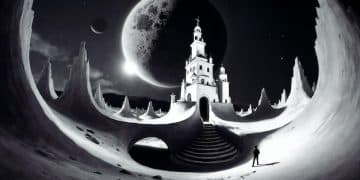Genre Blending: Crafting Unique Stories from Mixed Genres

Successful genre blending involves authors skillfully combining elements from disparate literary categories to forge truly unique narratives, engaging readers with unexpected complexities and innovative storytelling that transcends traditional boundaries.
The literary landscape is constantly evolving, and at its forefront stands the fascinating art of genre blending: how authors successfully combine elements from different genres to create unique stories. This innovative approach moves beyond traditional categorizations, inviting creators to weave together diverse threads of narrative, theme, and style. The result is often a richer, more complex tapestry that captivates readers and offers fresh perspectives on familiar tropes.
The Genesis of Genre Blending: Why Authors Mix It Up
The practice of mixing genres is not entirely new, yet its prevalence and sophistication have grown significantly. Authors often engage in genre blending to expand the narrative possibilities, offering readers something beyond the conventional. This pursuit of novelty can lead to groundbreaking works that challenge expectations and redefine what stories can be.
One primary motivation is to overcome the limitations of a single genre. Pure genre forms often come with established conventions and expectations, which, while comforting to some readers, can become restrictive for writers seeking to explore complex themes or unconventional character arcs. Blending allows for a broader spectrum of expressiveness, integrating elements that might otherwise feel out of place.
Another compelling reason is the desire to appeal to a wider audience. By incorporating elements from multiple popular genres, authors can draw in readers who might typically stick to one type of story. A mystery with a strong romantic subplot, for instance, could attract both mystery enthusiasts and romance readers, effectively doubling its potential reach and resonance.
Breaking Down Conventional Walls
Traditional genre definitions, while useful for classification, can sometimes stifle creativity. Authors who blend genres often seek to intentionally subvert these expectations, playing with reader assumptions to create surprising twists or deeper thematic resonance. This deliberate disruption can make for a more engaging and thought-provoking reading experience.
- Subverting Tropes: Blending allows authors to take common genre tropes and twist them, giving them new meaning or an unexpected context.
- Expanding Thematic Depth: Complex societal issues or philosophical questions may require multiple genre lenses to be fully explored.
- Challenging Reader Expectations: Surprise elements derived from unexpected genre shifts keep readers on their toes.
Ultimately, the genesis of genre blending lies in an author’s quest for originality and greater narrative freedom. It’s about pushing the boundaries of storytelling, creating tales that resonate deeply by drawing on a diverse palette of literary techniques and conventions. The success of such ventures often hinges on the author’s skill in seamlessly integrating disparate elements, making the fusion feel organic rather than forced.
This deliberate fusion enriches the narrative tapestry, allowing for explorations of characters and plots that simply wouldn’t be possible within the confines of a single, rigid genre. It’s a testament to the evolving nature of storytelling and the perpetual innovation within the literary world.
The Art of Seamless Integration: Making Blending Work
Achieving successful genre blending is far more complex than simply throwing two genres together. The true artistry lies in the seamless integration of elements, ensuring that the disparate components coalesce into a coherent and compelling whole. A poorly executed blend can lead to a disjointed narrative that confuses or alienates readers.
Authors must thoughtfully consider how each genre element serves the overarching story. It’s not about adding a sci-fi monster to a romance novel just for shock value; it’s about asking what that monster brings to the romantic dynamic, how it shapes the characters’ journey, or how it contributes to the thematic message. Every element should feel purposeful and organic to the narrative.
One key aspect of seamless integration is maintaining a consistent narrative voice and tone. While the content may shift from one genre’s convention to another, the underlying voice should remain cohesive. This consistency helps to anchor the reader, providing a stable foundation even as the plot ventures into unexpected territories. Tone can be tricky, as different genres often imply different tonal registers, but a skilled blinder finds a way to harmonize these, perhaps through irony, dramatic tension, or a unique character perspective.
Balancing the Scales: Proportion and Pacing
The proportion of each genre’s elements within the blend is crucial. An overly dominant genre can overshadow the others, negating the purpose of blending. Conversely, too many disparate elements vying for attention can lead to a chaotic narrative. Authors often employ a primary genre as the groundwork, then carefully weave in secondary genre elements to enhance, rather than derail, the central plot or themes.
- Strategic Introduction: Elements from secondary genres should be introduced gradually and organically, not abruptly.
- Harmonious Pacing: The pacing should fluidly transition between genre-specific moments, avoiding jarring shifts.
- Thematic Cohesion: Ensure all elements contribute to the narrative’s underlying themes, regardless of their genre origin.
Effective pacing is also vital. A good genre blend knows when to lean into the suspense of a thriller, the introspection of a literary drama, or the action of an adventure story. These shifts should feel natural, building and releasing tension in a way that keeps the reader engaged without feeling rushed or bogged down.
Ultimately, seamless integration is about creating a symbiotic relationship between genres. Each element should not only coexist but also enhance the others, resulting in a narrative that is greater than the sum of its parts. This delicate balance requires meticulous planning, a deep understanding of genre conventions, and a keen sense of narrative flow.

Popular Blends and Their Impact: Success Stories in Fusion
The literary landscape is rich with examples of successful genre blending, demonstrating the vast potential of this creative approach. These “success stories in fusion” often go beyond mere novelty, creating works that resonate deeply with readers and critics alike, sometimes even forging new subgenres in their wake.
Consider the rise of urban fantasy, a blend of traditional fantasy elements (magic, mythical creatures) with contemporary urban settings. Authors like Neil Gaiman and Jim Butcher have masterfully built entire worlds where fae co-exist with commuters or vampires lurk in city alleys. This blend offers the escapism of fantasy while keeping a relatable, modern backdrop, appealing to a broad audience who might find high fantasy intimidating.
Another popular and impactful blend is the historical mystery or historical thriller. Here, the meticulously researched settings and social conventions of historical fiction provide a rich, immersive backdrop for a gripping mystery or a high-stakes thriller. Authors such as C.J. Sansom or Boris Akunin transport readers to past eras, allowing them to both learn about history and be entertained by a compelling plot. The historical context often adds layers of intrigue and limitation that make the mystery even more compelling.
Beyond the Obvious: Unexpected Hybrids
Some of the most innovative blends emerge from combining genres that seem inherently disparate, creating truly unique and memorable reading experiences. These unexpected hybrids often challenge perceptions and push the boundaries of what stories can achieve.
- Sci-Fi Westerns: Merging futuristic technology with the rugged individualism and frontier spirit of the Old West (e.g., “Firefly”).
- Horror Comedies: Using humor to amplify or subvert the terror, often through satire or black comedy (e.g., “Shaun of the Dead”).
- Literary Fiction with Speculative Elements: Grounded character studies or explorations of the human condition infused with elements of science fiction or fantasy, often pushing the boundaries of realism for profound thematic effect.
The impact of these successful blends is significant. They provide fresh perspectives on familiar narratives, keeping the literary scene vibrant and dynamic. Moreover, they often pave the way for other authors to experiment, fostering an environment of innovation. Readers, in turn, benefit from a wider array of stories that cater to diverse tastes and offer complex, multifaceted experiences.
These successful fusions highlight that genre blending is not merely a gimmick, but a potent tool for creating rich, nuanced, and enduring literary works. The ability to cross these boundaries skillfully is a testament to an author’s understanding of storytelling craft and their imaginative vision.
Challenges and Pitfalls: When Blending Goes Wrong
While the rewards of successful genre blending are significant, the path is fraught with challenges. The very act of combining disparate elements can lead to pitfalls that undermine the narrative, confuse the reader, or simply result in a disjointed and unsatisfying story. Recognizing these potential issues is crucial for authors aiming to master this art.
One of the most common pitfalls is simply forcing the blend. This occurs when an author adds elements from another genre without a clear narrative purpose. If the horror element in a romance novel feels shoehorned in, or the sci-fi tech in a fantasy story is inconsistent, readers will notice. The blend must feel organic, as if the elements were always meant to coexist, rather than being patched together out of convenience or a desire to be trendy.
Another significant challenge is tone inconsistency. Different genres often carry specific tonal expectations – a comedy is lighthearted, a thriller is tense, a literary novel is often reflective. Blending these without careful consideration can result in tonal whiplash, leaving readers unsure how to feel or react. A sudden shift from dramatic tension to slapstick humor, for example, can break immersion and undermine the story’s credibility.
Maintaining Cohesion and Credibility
Establishing and maintaining internal consistency is paramount, especially when blending genres with differing rules or world-building conventions. If you combine fantasy and sci-fi, how do magic and advanced technology interact? Are there rules governing this interaction, or does it feel arbitrary? A lack of clear guidelines can lead to a loss of reader trust and a sense that “anything can happen,” which often translates to “nothing matters.”
- Illogical Rules: Failure to establish and adhere to logical rules for combined genre elements can break reader immersion.
- Character Incoherence: Characters acting out of sync with established genre norms or their own developed personalities.
- Overly Ambitious Scope: Trying to blend too many genres or elements can lead to a sprawling, unfocused narrative.
The audience’s expectations also present a challenge. Readers often come to a book with preconceived notions based on its initial categorization or marketing. If a book promises a fantasy adventure but then veers heavily into political thriller territory without proper setup, some readers may feel misled or disappointed. Managing these expectations through clear marketing and careful narrative progression is essential.
Ultimately, the main pitfall in genre blending is a lack of narrative control and intentionality. Without a clear vision for how each element serves the whole, or how to seamlessly transition between them, authors risk creating a muddled and unsatisfying reading experience. Successful blending requires discipline, a deep understanding of each genre’s mechanics, and the courage to make difficult editorial choices.
Techniques for Authors: Mastering the Mix
For authors aiming to master the art of genre blending, various techniques can be employed to ensure a cohesive and compelling narrative. It’s about approaching the fusion not as a disjointed addition, but as an integral part of the story’s DNA. These techniques empower writers to navigate the complexities of mixing genres effectively.
One fundamental technique involves identifying the core elements of each genre you wish to combine. What are the essential tropes, character archetypes, narrative structures, and thematic concerns of, say, a mystery versus a romance? Once these core elements are understood, the author can then strategically select which ones to integrate, always with an eye toward how they can complement or subvert each other, rather than clash.
Another powerful technique is the concept of a unifying theme or unique premise. A strong central idea can act as the glue that holds disparate genre elements together. For instance, a story exploring the nature of identity could blend psychological thriller elements with philosophical science fiction, using both to delve deeper into the core theme. The premise itself might be genre-bending, setting the stage for the reader’s expectations from the outset.
Strategic Application of Elements
Authors often benefit from a “layered” approach to blending, where one genre forms the primary layer, and others are woven in as secondary or tertiary layers. This helps maintain narrative stability while still introducing diversity. For instance, a literary novel might have a strong magical realism layer that subtlely alters perceptions without dominating the narrative.
- Character-Driven Integration: Allow characters to embody the clash or combination of genres, driving the narrative through their unique perspectives.
- Setting as a Blend: Create a setting that inherently combines elements from different genres, making the fusion feel natural.
- Pacing Variation: Utilize the pacing conventions of different genres to create varied rhythms and maintain reader engagement.
It is also beneficial to use voice and style as tools for blending. An author might employ a cynical, hard-boiled detective voice in a fantasy setting, instantly creating a unique tone that encapsulates the genre blend. Similarly, stylistic choices, such as alternating between lyrical prose and stark, journalistic descriptions, can reinforce the genre fusion on a deeper level.
Finally, iterative drafting and revision are indispensable. Very rarely does a perfect genre blend emerge in a first draft. Authors must be willing to experiment, revise, and sometimes even strip away elements that aren’t working. Getting feedback from beta readers who understand the nuances of the intended blend can also be invaluable, helping to identify areas where the fusion feels forced or unclear.

Reader Expectations and Reception: The Audience’s Role
The success of genre blending isn’t solely dependent on the author’s skill; reader expectations and reception play a crucial role. Understanding what the audience anticipates, and how they react to unconventional narratives, is paramount for authors venturing into hybrid territory. This interaction largely shapes how widely a blended work is embraced.
Many readers are drawn to genre fiction precisely because of its established conventions. They enjoy the comfort of knowing what to expect from a thriller, a romance, or a fantasy novel. When an author blends genres, they challenge these expectations, which can be either exhilarating or off-putting. Some readers revel in the surprise and originality, while others may feel disoriented or that their preferred genre’s integrity has been compromised.
Authors must effectively signal their intention to blend genres, either through marketing, cover design, or the opening chapters of the book. A clear indication helps manage reader expectations and attracts an audience more open to cross-genre experiences. Misleading labeling can lead to negative reviews from readers who feel the book wasn’t what they signed up for, even if the blending itself was well-executed.
The Evolving Palate of the Modern Reader
Despite the potential for resistance, there’s a growing appetite among modern readers for innovative and complex narratives. The digital age, with its endless array of content, has fostered a more experimental readership. Many readers are actively seeking stories that break molds, offering fresh perspectives and challenging conventional storytelling. This evolving palate is a driving force behind the rise of successful genre blending.
- Desire for Novelty: Readers are increasingly searching for unique stories that go beyond familiar genre tropes.
- Word-of-Mouth Amplification: Successfully blended novels often generate significant buzz due to their distinctiveness.
- Subgenre Formation: Reader enthusiasm can lead to the codification of new subgenres, legitimizing the blending.
User reviews and online communities (like Goodreads, Reddit, and specific genre forums) play a significant role in shaping reception. If a blended novel resonates with influential readers, positive word-of-mouth can quickly spread, validating the author’s creative choices and attracting new fans. Conversely, negative reactions can quickly stifle a book’s potential, highlighting the importance of balancing innovation with reader satisfaction.
Ultimately, the reception of genre-blended works is a dynamic interplay between authorial intent and audience interpretation. Authors must not only craft compelling narratives but also understand their target readership’s desires and willingness to engage with the unconventional. When this balance is struck, the result is a truly unique reading experience that leaves a lasting impression.
The Future of Storytelling: What’s Next for Genre Blending?
As we look to the horizon, the future of storytelling seems inextricably linked with the continued evolution of genre blending. What was once an experimental niche is increasingly becoming a mainstream approach, suggesting exciting prospects for authors and readers alike. The boundaries between genres are likely to become even more fluid, paving the way for truly unprecedented narratives.
One major trend is the increasing sophistication of blending. As authors gain more experience and readers become more accustomed to hybrid forms, the craft of integration will likely deepen. This could lead to more nuanced, complex, and subtle blends, where the seams between genres are virtually invisible, creating a seamless narrative experience that transcends categorization.
Furthermore, technology will undoubtedly play a pivotal role. Interactive storytelling platforms, virtual reality, and AI-assisted creativity could open new dimensions for genre blending. Imagine a narrative where the reader’s choices could shift the story from a detective mystery to a cosmic horror, dynamically altering the genre elements based on user interaction. These innovations could make genre blending an immersive, personalized experience.
Emerging Trends and Uncharted Territories
We may see the emergence of highly specialized micro-genres born from specific blends, reflecting an ever-fragmenting yet highly engaged readership. These hyper-focused combinations could cater to very specific tastes, driving further innovation and niche markets.
- Cross-Media Blending: As storytelling extends beyond books into film, gaming, and interactive experiences, genre blending will evolve across these diverse platforms.
- Thematic Blending: Future blends might focus less on concrete genre elements and more on thematic fusions, like “existential sci-fi” or “social justice fantasy.”
- Cultural Crossover: Blending genres from different cultural storytelling traditions could become more prevalent, creating rich and diverse narrative hybrids.
The role of global interconnectedness cannot be overstated. As literature transcends geographical boundaries, authors will draw inspiration from diverse storytelling traditions, combining narrative techniques and genre conventions from around the world. This cultural crossover will undoubtedly lead to novel and exciting forms of genre blending, enriching the global literary landscape.
Ultimately, the future of genre blending points towards a more open-ended and expansive concept of storytelling. It signifies a move away from rigid classifications and towards an embrace of fluidity, complexity, and originality. Authors will continue to push the envelope, creating stories that defy easy definition, reflecting the multifaceted nature of human experience and imagination. The only constant will be the relentless pursuit of the unique, ensuring that the art of narrative remains vibrant and perpetually surprising.
| Key Aspect | Brief Description |
|---|---|
| ✨ Why Blend? | Authors mix genres to overcome limitations, expand narrative possibilities, and appeal to diverse audiences with unique stories. |
| 🎨 Seamless Integration | True artistry lies in making disparate elements coalesce into a coherent whole, maintaining consistent voice, tone, and purposeful inclusion. |
| ⚠️ Challenges | Pitfalls include forced blends, tonal inconsistency, and illogical rules that can confuse readers or undermine narrative credibility. |
| 🚀 Future Outlook | Sophistication, technology, and cultural exchange will drive even more nuanced and immersive genre blending experiences. |
Frequently Asked Questions About Genre Blending
Genre blending in literature refers to the practice of combining elements, conventions, and tropes from two or more distinct literary genres into a single narrative. This creates a hybrid story that offers readers a fresh and often more complex experience than a pure genre novel.
Authors blend genres to break free from traditional boundaries, explore complex themes, add unexpected twists to familiar narratives, and appeal to a wider range of readers. It allows for greater creative freedom and often results in more innovative and thought-provoking stories.
Common challenges include maintaining narrative cohesion, ensuring tonal consistency, avoiding forced integration of elements, and managing reader expectations. If not carefully executed, blending can lead to disjointed plots or a confusing reading experience for the audience.
Yes, absolutely. Successful and influential genre blending often leads to the emergence of entirely new subgenres. Examples include Urban Fantasy (fantasy + contemporary), Historical Mystery (history + mystery), or Sci-Fi Westerns. These new categories help readers and publishers define and categorize innovative works.
Genre blending impacts reader experience by offering novelty, challenging expectations, and providing richer, more complex narratives. While some readers might initially be hesitant, many embrace the unique perspectives and heightened engagement that well-executed blended stories can deliver.
Conclusion
Genre blending stands as a testament to the boundless creativity within storytelling. It’s a craft that demands precision, thoughtful integration, and an acute awareness of both the distinct elements of each genre and the overarching narrative vision. As authors continue to push boundaries and readers increasingly seek out original experiences, this innovative approach will undoubtedly remain a cornerstone of literary evolution. The unique stories born from these fusions not only entertain but also broaden our understanding of what literature can achieve, making the future of storytelling an exciting, undefinable landscape.





